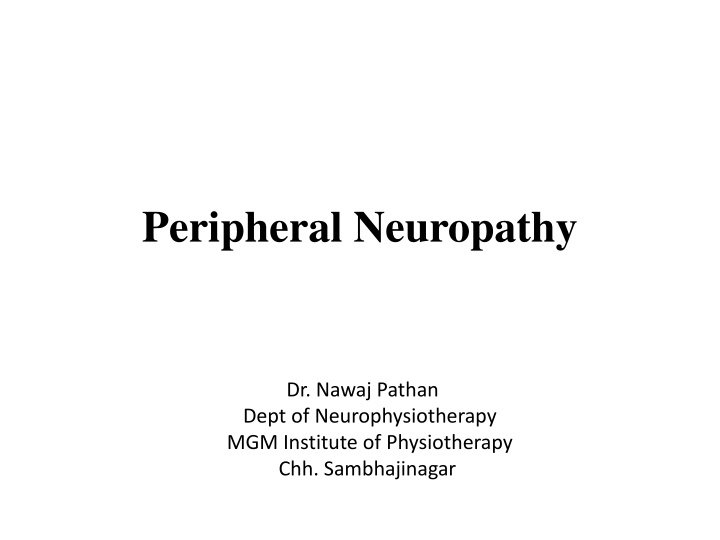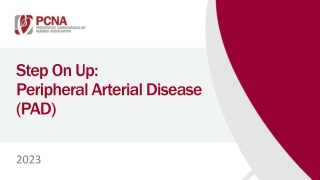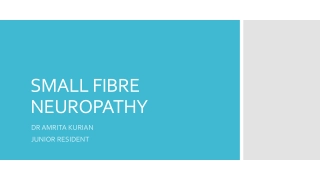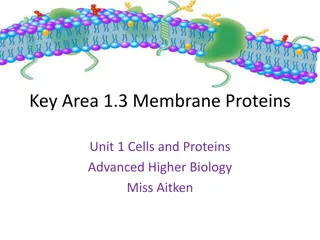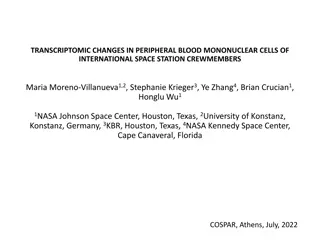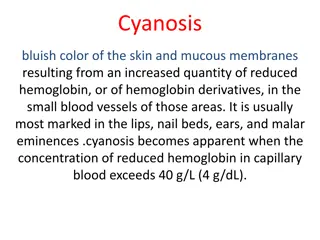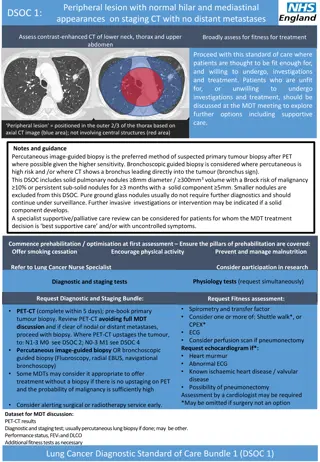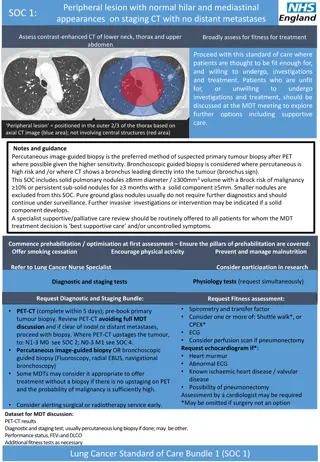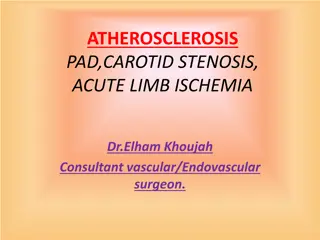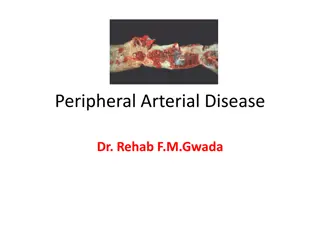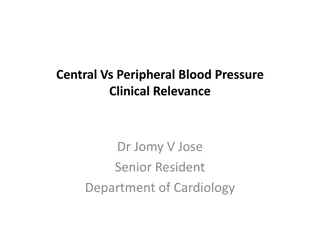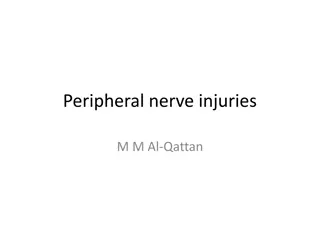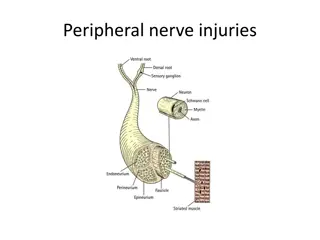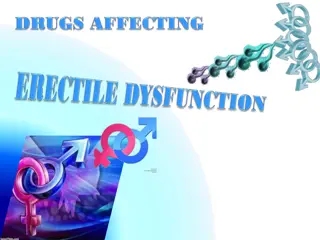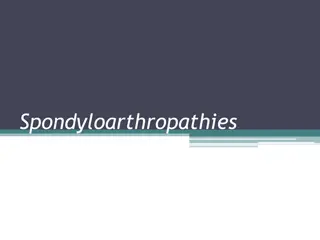Peripheral Neuropathy Mechanisms
Peripheral neuropathy involves nerve damage causing motor and sensory impairments. Pathological mechanisms include immune attacks, arterial diseases, and genetic factors affecting myelination. These lead to motor neuron lesions, muscle atrophy, and deformities, highlighting the importance of early diagnosis and treatment in reducing long-term complications.
Download Presentation

Please find below an Image/Link to download the presentation.
The content on the website is provided AS IS for your information and personal use only. It may not be sold, licensed, or shared on other websites without obtaining consent from the author.If you encounter any issues during the download, it is possible that the publisher has removed the file from their server.
You are allowed to download the files provided on this website for personal or commercial use, subject to the condition that they are used lawfully. All files are the property of their respective owners.
The content on the website is provided AS IS for your information and personal use only. It may not be sold, licensed, or shared on other websites without obtaining consent from the author.
E N D
Presentation Transcript
Peripheral Neuropathy Dr. Nawaj Pathan Dept of Neurophysiotherapy MGM Institute of Physiotherapy Chh. Sambhajinagar
It is important to have a clear concept of the extent of the peripheral nervous system. It includes all neural structures lying outside the pial membrane of the spinal cord and brainstem with exception of the optic nerves and olfactory bulbs. The nerve fibers are coated with the short segments of myelin throughout of its length.
Pathologic mechanism in PND Its intimate relation with CSF and the specialized arachnoidal cells, a pathological process in CSF or Leptomeninges may damage the exposed spinal roots. Diseases of connective tissues may affect the nerve roots as they lie in their sheaths. Diffuse or localized arterial diseases may injure nerves by occluding their nutrient arteries.
Large categories of immune-mediated neuropathies are common as a result of a cellular attack on myelin sheath. This will results into blocked electrical conduction. Few diseases and toxins also have their effects on peripheral neuropathies. Diphtheria, in which bacterial toxins may act directly on membrane of schwann cells near the dorsal root ganglia and adjacent parts of both sensory and motor nerves.
Polyarteritis nodusa, which causes widespread occlusion of vasa nervosa resulting multifocal nerve infarction. Doxorubicin intoxication wherein protein synthesis of dorsal root ganglia cells is blocked with subsequent neuronal destruction following arsenic poisoning. Among the genetically determined diseases neuropathies, the altered gene product is now known as main factor lead to defective myelination which greatly slows down the conduction . Structural components of the axon are at disruption,leading to axonal degeneration.
Effects of Peripheral Nerve Injuries Motor changes are as follows- Interruption of motor nerve conduction produces the lower motor neuron lesion with loss of reflexes, tone and loss of active ROM. This is followed by atrophy of both muscles and soft tissues. Deformities are caused by unopposed action of the muscles e.g. Claw hand= ulnar nerve.
Adhesions may form between the tendons and sheathes and also in the joints due to lack of movements. Muscles becomes fibrosed after long period of denervation. Typically in polyneuropathies, symmetrical distribution of weakness or paralysis is significant. In cases of diffuse axonal damage, muscles of feet and legs are affected earlier & more severely than those of hands and forearm.
In milder cases of axonal damage, only feet and lower legs are affected, truncal muscles are usually last to yield. This represent the Length dependent pattern of axonal degeneration. The atrophy of weak or paralyzed muscles is slow process and takes the several months. Maximum degree of denervation occurs in 90 to 120 days, reduces the muscle volume by 70 to 80%.
Sensory changes are as follows- All sensory sensation may be affected or eventually lost. In polyneuropathies both sensory and motor impairments are common, one may be more affected than other. In most of the toxic and metabolic neuropathies, sensory loss exceeds weakness. Sensation is affected symmetrically in the distal segments of the limbs, more in legs than arms, in the severe cases this may spread to proximally.
Superficial sensations may be impaired more than deep. Vibratory sense is more impaired than position and tactile sense. In severe cases the sensory loss may spread up to the anterior abdomen, thorax, and face.(Escutcheon pattern) Most often it is wrongly diagnosed as spinal cord lesion.
Paraesthesia Pain & Dysesthesias Especially marked in the hands and feet. Pins and needles, stabbing, tingling, prickling, electrical, are the adjectives chosen by patients to describe these abnormalities. In some sensory neuropathies paresthesias and numbness are the only demonstrable features; objective sensory loss is lacking.
It has been theorized that a loss of large touch, pressure fibers disinhibits the pain-receiving nerve cells in the posterior horns of the spinal cord. The mechanism of thermal and painful dysesthesias is not fully understood. Painful paresthesias and Dysesthesia are particularly common in diabetic, alcoholic-nutritional, and amyloid neuropathies. Mainly they affect the feet ( burning feet ) and less often the hands.
Deformity and Trophical Changes Feet, hands, and spine become deformed. Denervation, atrophy of muscle can be considered the main factors for the tropical disturbance resulting from interruption of the motor nerves. There are numerous other changes. In particular, analgesia of distal parts makes them susceptible to burns, pressure sores, and other forms of injury that are easily infected and heal poorly.
In an anesthetic and immobile limb, the skin becomes tight and shiny, scaly. Nails turned into curved and rigid, and the subcutaneous tissue thickened ( trophic changes ). Hair growth is diminished in denervated areas. If the autonomic fibers are interrupted, the limb is warm and pink
Autonomic Dysfunction Anhidrosis and orthostatic hypotension are the most frequent manifestations of autonomic dysfunctions lack of sweat, tears, and saliva, sexual impotence, weak bowel and bladder sphincters with or without urinary retention or overflow incontinence and weakness, dilatation of the esophagus and colon are the other common manifestations seen. Leg cramps, spasm, fasiculations are the other symptoms patient may report.
PT Mx. Problem list- Sensory impairment in the extremities Active ROM Muscle weakness Atrophy of muscles Deformity/s prevention Contracture/s prevention.
